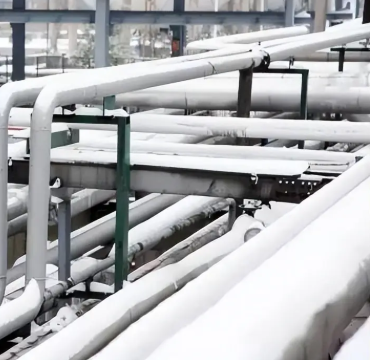



In winter, especially in the north, as the temperature drops, when the measured medium is transmitted to the transmitter through the measuring pipeline, the flow meter often freezes, solidifies, and crystallizes due to the low ambient temperature. The low ambient temperature exceeds the normal working temperature range of the instrument used, which directly affects the accuracy of the instrument measurement display. The measuring medium of various instrument points such as pressure, flow, liquid level, and temperature is mostly liquid, which is more likely to cause measurement errors due to the influence of low temperature. In severe cases, it may cause safety accidents such as poisoning, fire, and explosion.
Therefore, it is particularly important to protect flowmeters and other instruments from freezing and frost every winter. Some large instrument users have made preparations in advance. For example, power plants, petroleum, chemical, water plants, etc. have formulated a system for protecting instruments from freezing and frost that is suitable for their own enterprises, and have carried out various work such as freezing and sewage treatment on the instruments. In this issue, we will discuss how instrument users can protect instruments from freezing and frost in winter.
To protect the instrument from freezing, the product selection is a key. When installing the instrument in the early stage, the instrument user should consider the working conditions of the instrument and select the instrument with insulation device. According to the type and purpose of the instrument and the geographical location to be installed, the insulation and antifreeze requirements of the instrument should be proposed and then submitted to the manufacturer for processing.

1. Flow meter insulation measures
Use insulation materials to keep warm, that is, wrap the parts of the instruments that are easy to freeze or afraid of freezing with insulation materials. When winter comes, check and drain frequently to prevent the insulation materials from being damaged.
2. Flow meter heating measures
1. Steam tracing measures: use pipe steam heating for heat preservation. Before delivering steam in winter, check whether the steam insulation pipeline is unobstructed or blocked. It is best to have steam flowing 24 hours a day and not too hot. Sometimes the amount of steam supply should be adjusted according to weather temperature changes to prevent the condensate in the pressure lead pipe of the transmitter from vaporizing due to high temperature and affecting the operation of the transmitter, or freezing due to low temperature and affecting the smooth operation of the transmitter.
2. Instrument insulation box measures:
a. The electric heating tube heat preservation box is composed of three parts: box body, heater, instrument bracket, etc. Its structure is the same as the protection box, but the difference is that the box is equipped with an electrical heating device, which is composed of electric heating tubes and temperature controllers. There is a socket on the side of the box. When the power is turned on, the box is heated to the required temperature, and then the temperature controller is connected to the power to continue heating. Through repeated work, the temperature in the box can be kept within a certain range. The main parameters of its constant temperature heater are:
⑴, Rated voltage 200V.50Hz;
⑵, Rated power 300 ~ 500W;
⑶. The control temperature can be set by the user;
⑷. Constant temperature heater can also be made into explosion-proof type;
⑸. There are three types of electric heating tube materials: copper tube, carbon steel tube and stainless steel tube.
b. Steam pipe heat insulation box, the heat pipe is made of metal pipe into S-shaped structure. The upper and lower parts of the box body are welded with the heat pipe by welding type through-plate joints. The heat pipe is installed in the box with the upper inlet and the lower outlet. The purpose of heating is achieved by the circulation of steam in the pipe cavity. The heat pipe material is generally divided into two types, namely copper pipe and seamless steel pipe (carbon steel).
c. Add another layer of insulation cotton to the key instrument box, and seal the door of the insulation box and the inlet and outlet of the pipeline with glue to achieve better insulation and anti-freeze effect for the instrument system.
3. Flow meter maintenance measures
1. Installation measures: Choose a reasonable installation location: a dry place without rain or snow dripping.
2. Inspection measures: If conditions permit, a dedicated person shall conduct technical confirmation and technical treatment on a daily basis to check whether the insulation materials are damaged and whether the steam pipelines are blocked.
3. Alarm measures. If conditions permit, a small sound and light alarm device can be installed to detect steam leakage or power failure, so as to facilitate the discovery and timely rectification of hidden dangers of thermal insulation and antifreeze measures.
4. Inspection measures. The person responsible for regional instrument maintenance shall conduct regular inspections according to the scheduled inspection routes. During the inspection, it is necessary to check whether the insulation pipeline valves, insulation boxes, drain devices, insulation material packaging are intact, and electric heating power supply components are normal. Focus on the inspection of instruments in the easy-to-freeze device and keep inspection records. Perform dry, complete, and clean maintenance on the instruments and their insulation and anti-freeze measures, and promptly solve insulation and heating problems on site.
a. Before sending steam, check whether the insulation pipeline is unobstructed. In addition, check and drain the pipe frequently in winter to prevent the insulation pipe from being blocked. Once it is blocked, it is easy to freeze, which will cause big trouble. Sometimes the steam supply should be adjusted according to the temperature change to prevent the condensate in the pressure pipe of the transmitter from vaporizing due to high temperature and affecting the operation of the transmitter.
b. In the north, the most important problem in winter is the insulation of instrument equipment. As a grassroots maintenance staff, we conduct a comprehensive inspection of the insulation and heating problems of all instrument equipment before the winter comes. For the instrument equipment that often fails due to insulation and heating in previous winters, we report it to the workshop collectively, discuss it together, and study the solution. The first consideration is to make a good insulation layer and add heating wires. As for the choice of electric heating, steam heating or low-temperature water heating, it depends on the specific situation. If the insulation and heating are done well, but the instrument still fails, then consider replacing the measuring instrument, such as replacing the original buoy with a double flange, etc. So that the instrument equipment can spend the winter normally and smoothly. In this way, the workload of the instrument maintenance worker is small and the production is stable. Use insulation materials to keep warm, that is, use insulation materials to wrap the parts of the instrument that are easy to freeze or afraid of freezing. When winter comes, check and drain frequently to prevent the insulation materials of the packaging from being damaged.